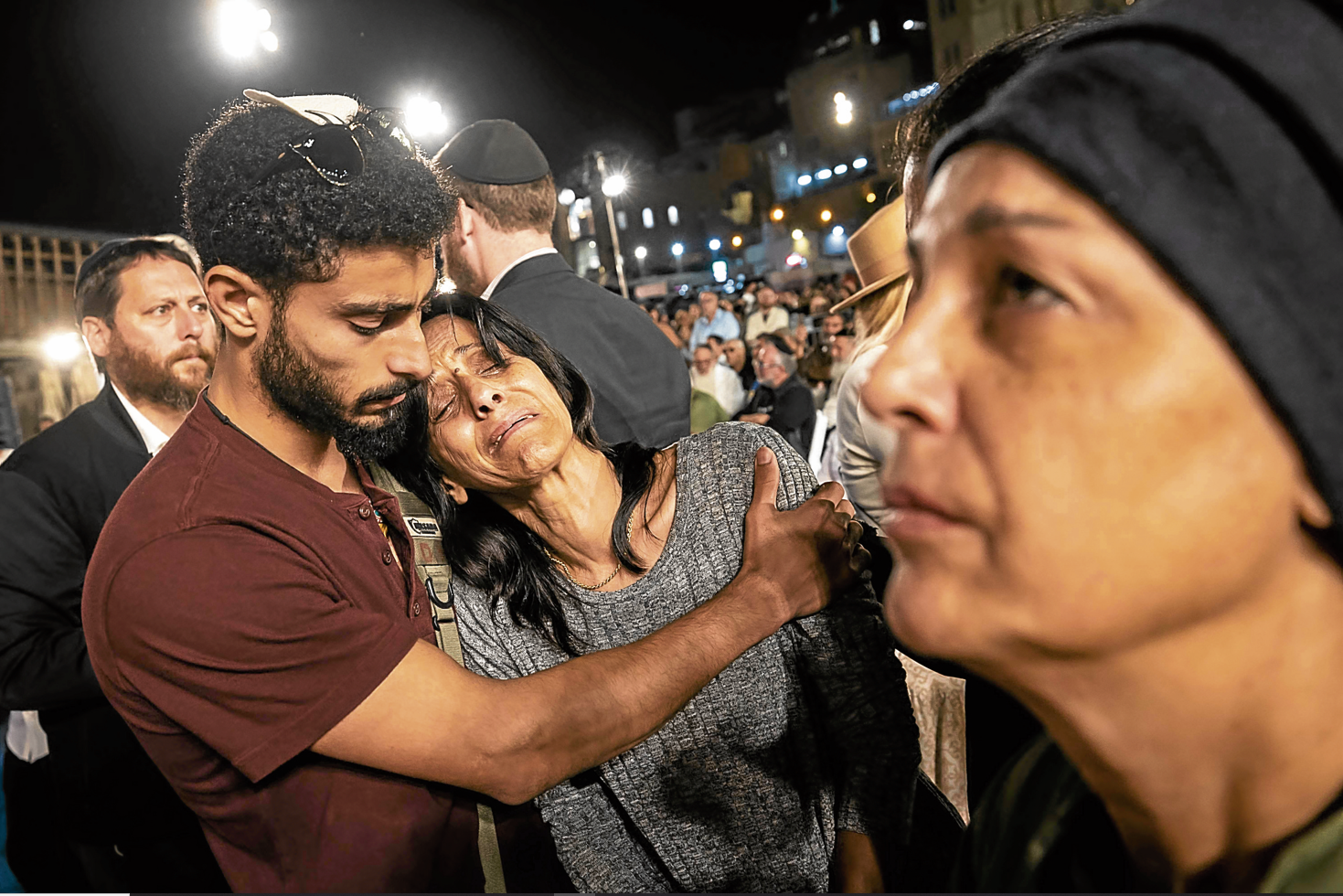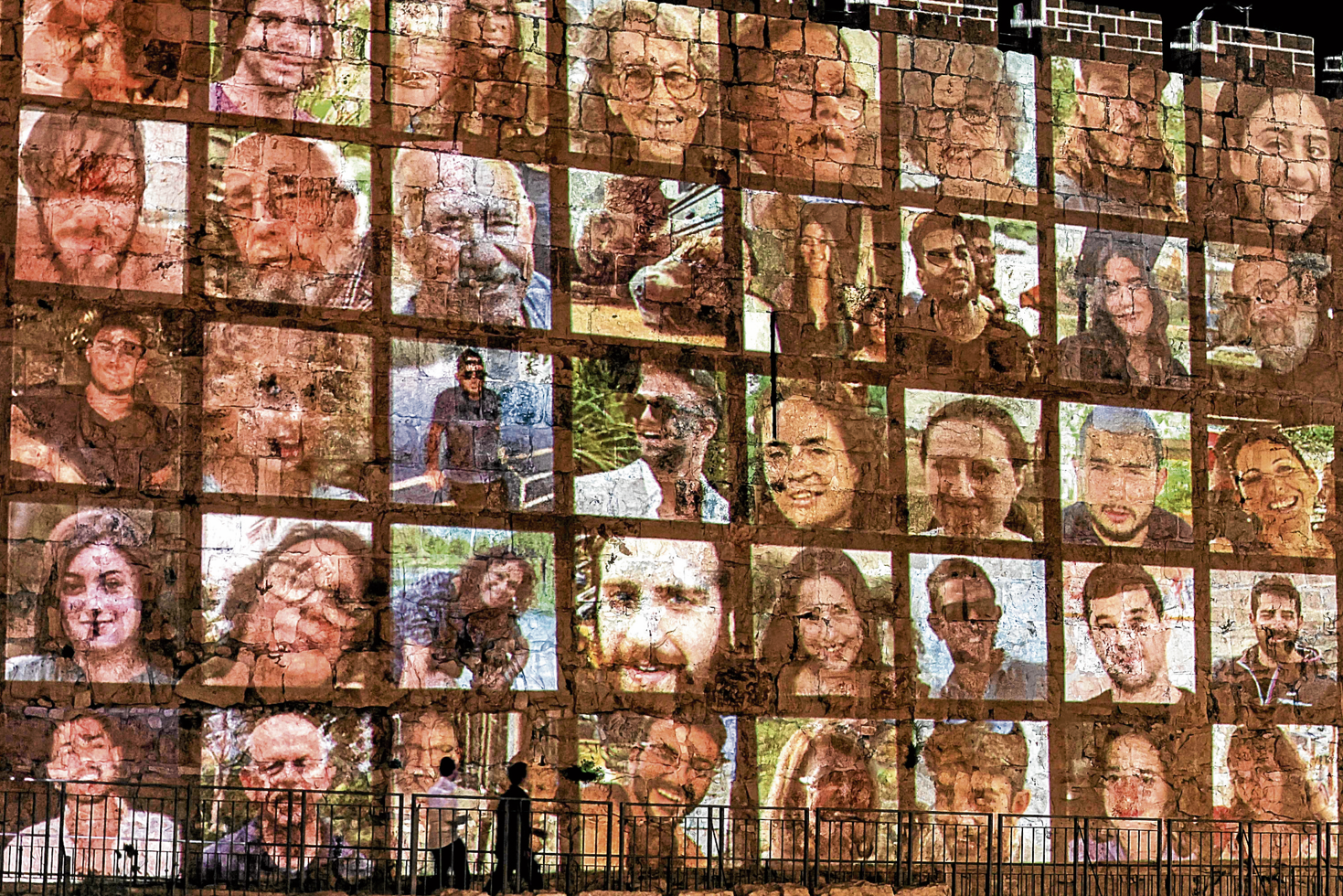Relatives of Hamas attack victims mark one month of mourning

A NATION GRIEVES Photographs of hostages kidnapped by Hamas militants are projected on Jerusalem’s Wailing Wall on Nov. 6, the eve of the commemoration of the Oct. 7 Hamas attacks on Israel. Relatives of some of the 1,400 people killed in the attacks gathered at this holy site to pray for the dead and for the hostages still in the clutches of the militants. —AFP
JERUSALEM/GAZA—Relatives of some of the 1,400 people killed in the Oct. 7 Hamas attacks on Israel gathered at Jerusalem’s Wailing Wall to mark a month of mourning on Monday night.
Meanwhile, United Nations Secretary General Antonio Guterres warned that Gaza is becoming a “graveyard for children,” with the death toll from Israeli strikes exceeding 10,000, according to Palestinian health authorities.
Prime Minister Benjamin Netanyahu said Israel would consider “tactical little pauses” in the fighting to facilitate the entry of aid or the exit of hostages from the Gaza Strip.
At Jerusalem’s Wailing Wall, around 40 families lit candles for each victim at the entrance of the holy site, considered the most sacred place Jews can worship, during prayers marking the first month of grief in line with Jewish tradition.
Hostages remembered
“We don’t have other ways to commemorate them except with prayers, lighting candles and having them in our hearts,” said Yossi Rivlin, who lost two brothers at a music festival massacre during the Hamas attacks.
“This unity of the Israeli nation, we feel it not only in our house but all around the country. Too bad we had to wait for this moment,” the 26-year-old said.“It’s a terrible time. I just hope we won’t forget and return to our routine,” he added.Standing before a giant Israeli flag, army chief cantor Shai Abramson gave a prayer for the departed, modified to include a blessing for security forces who “paid with their lives for the protection of Israeli land.”
Apart from the tributes to those who were killed, the faces of some 240 hostages still in the clutches of Hamas were also projected onto the wall of the Old City.
The ceremony was the first religious commemoration organized at the Wailing Wall since the Oct. 7 attacks, the deadliest the nation has suffered since its founding in 1948.
It was attended by Benny Gantz, a member of the war Cabinet formed by Netanyahu in the wake of the attacks.

A NATION GRIEVES Photographs of hostages kidnapped by Hamas militants are projected on Jerusalem’s Wailing Wall on Nov. 6, the
eve of the commemoration of the Oct. 7 Hamas attacks on Israel. Relatives of some of the 1,400 people killed in the attacks gathered at
this holy site to pray for the dead and for the hostages still in the clutches of the militants. —AFP
‘Graveyard for children’
Israel has been pounding the densely populated Gaza Strip in a bid to “eliminate Hamas.”The health ministry in the Hamas-run territory said on Monday the death toll in Gaza was now at 10,022, including 4,104 children.
Supporting demands for a ceasefire, Guterres warned that “Gaza is becoming a graveyard for children. Hundreds of girls and boys are reportedly being killed or injured every day.”
“Ground operations by the Israel Defense Forces and continued bombardment are hitting civilians, hospitals, refugee camps, mosques, churches and UN facilities—including shelters. No one is safe,” he told reporters.
“At the same time, Hamas and other militants use civilians as human shields and continue to launch rockets indiscriminately toward Israel,” he said, as he called for the immediate and unconditional release of all hostages.
Guterres said 89 people working with the United Nations Relief and Works Agency (UNRWA), the world body’s agency for Palestinian refugees, were among the dead.
The UNRWA on Monday said five colleagues had been killed in the past 24 hours alone.
Gaza’s health ministry said dozens of people were killed by Israeli airstrikes in the north and south, including on Gaza City’s Rantissi cancer hospital where eight people were killed.
Israel’s military said it was looking into the report.
The health ministry also said an airstrike had hit a building belonging to Gaza’s largest hospital, Al Shifa, killing one person and injuring several others.
Some 170 people were being treated and hundreds of evacuees were sheltered at Al Shifa. But Israel said it had not struck the hospital.
‘We got children’
Israel, nevertheless, reiterated that Hamas was hiding among the civilians—including at the hospitals. Hamas described that claim as a “false narrative.”
Meanwhile, people continued to search for victims or survivors at the Maghazi refugee camp, where the health ministry said Israeli forces had killed at least 47 people in strikes early on Sunday.
“All night I and the other men were trying to pick the dead from the rubble. We got children, dismembered, torn-apart flesh,” said Saeed al-Nejma, 53.
Asked for comment, the Israeli military said it was gathering details.
‘It’s been 30 days’
The Israeli military also said a four-hour window for civilians to leave the north would be repeated daily.
But UN monitoring showed fewer than 2,000 people using that corridor on Sunday, citing fear and road damage.
A US envoy said on Saturday between 350,000 and 400,000 people were still in the north.A statement by 18 UN agencies called for an “immediate humanitarian ceasefire.”
“It’s been 30 days. Enough is enough. This must stop now,” they said.
Both Israel and Hamas, however, reject a ceasefire. Israel said the hostages should be released first, while Hamas said it will not free them or stop fighting while Gaza is under assault.But Netanyahu said that while he doesn’t think there will be a general ceasefire, “tactical little pauses” were still possible.
“An hour here, an hour there—we’ve had them before. I suppose we’ll check the circumstances in order to enable goods, humanitarian goods to come in, or our hostages, individual hostages, to leave,” the Israeli leader told ABC News on Monday.
US President Joe Biden had discussed such pauses and possible hostage releases in a phone call with Netanyahu also on Monday. —REPORTS FROM AFP AND REUTERS